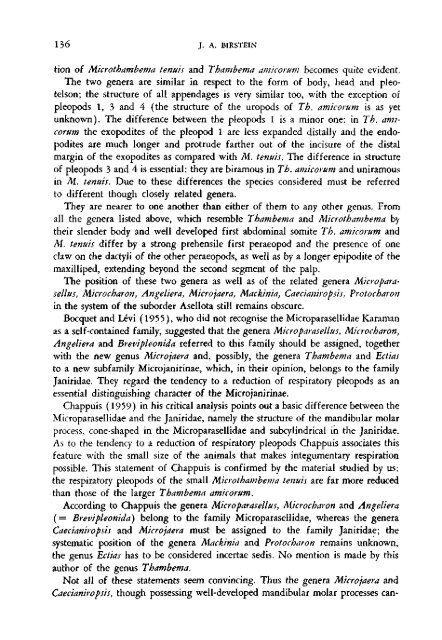MICROTHAMBEMA TENUIS N. GEN., N. SP. (ISOPODA ASELLOTA ...
MICROTHAMBEMA TENUIS N. GEN., N. SP. (ISOPODA ASELLOTA ...
MICROTHAMBEMA TENUIS N. GEN., N. SP. (ISOPODA ASELLOTA ...
Create successful ePaper yourself
Turn your PDF publications into a flip-book with our unique Google optimized e-Paper software.
136 J. A. BIRSTEIN<br />
tion of Microthambema tenuis and Thambema amicorum becomes quite evident.<br />
The two genera are similar in respect to the form of body, head and pleotelson;<br />
the structure of all appendages is very similar too, with the exception of<br />
pleopods 1, 3 and 4 (the structure of the uropods of Tb. amicorum is as yet<br />
unknown). The difference between the pleopods 1 is a minor one: in Tb. amicorum<br />
the exopodites of the pleopod 1 are less expanded distally and the endopodites<br />
are much longer and protrude farther out of the incisure of the distal<br />
margin of the exopodites as compared with M. tenuis. The difference in structure<br />
of pleopods 3 and 4 is essential: they are biramous in Th. amicorum and uniramous<br />
in M. tenuis. Due to these differences the species considered must be referred<br />
to different though closely related genera.<br />
They are nearer to one another than either of them to any other genus. From<br />
all the genera listed above, which resemble Thambema and Microthambema by<br />
their slender body and well developed first abdominal somite Tb. amicorum and<br />
Af. tenuis differ by a strong prehensile first peraeopod and the presence of one<br />
claw on the dactyli of the other peraeopods, as well as by a longer epipodite of the<br />
maxilliped, extending beyond the second segment of the palp.<br />
The position of these two genera as well as of the related genera Microparasellus,<br />
Microcharon, Angeliera, Mkrojaera, Machinia, Caeciamropsis, Protocharon<br />
in the system of the suborder Asellota still remains obscure.<br />
Bocquet and Levi (1955), who did not recognise the Microparasellidae Karaman<br />
as a self-contained family, suggested that the genera Microparaseltus, Microcharon,<br />
Angeliera and Brevipleonida referred to this family should be assigned, together<br />
with the new genus Mkrojaera and, possibly, the genera Thambema and Ectias<br />
to a new subfamily Microjanirinae, which, in their opinion, belongs to the family<br />
Janiridae, They regard the tendency to a reduction of respiratory pleopods as an<br />
essential distinguishing character of the Microjanirinae.<br />
Chappuis (1959) in his critical analysis points out a basic difference between the<br />
Microparasellidae and the Janiridae, namely the structure of the mandibular molar<br />
process, cone-shaped in the Microparasellidae and subcylindrical in the Janiridae.<br />
As to the tendency to a reduction of respiratory pleopods Chappuis associates this<br />
feature with the small size of the animals that makes integumentary respiration<br />
possible. This statement of Chappuis is confirmed by the material studied by us:<br />
the respiratory pleopods of the small Microthambema tenuis are far more reduced<br />
than those of the larger Thambema amicorum.<br />
According to Chappuis the genera Microparasellus, Microcharon and Angeliera<br />
(= Brevipleonida) belong to the family Microparasellidae, whereas the genera<br />
Caeciamropsis and Mkrojaera must be assigned to the family Janiridae; the<br />
systematic position of the genera Mackinia and Protocharon remains unknown,<br />
the genus Ectias has to be considered incertae sedis. No mention is made by this<br />
author of the genus Thambema,<br />
Not all of these statements seem convincing. Thus the genera Mkrojaera and<br />
Caecianiropsis, though possessing well-developed mandibular molar processes can-
















